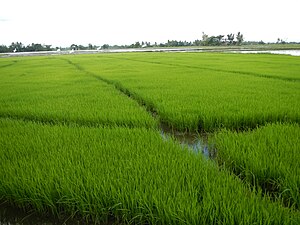
Agriculture in the Philippines is a major sector of the economy, ranking third among the sectors in 2022 behind only Services and Industry. Its outputs include staples like rice and corn, but also export crops such as coffee, cavendish banana, pineapple and pineapple products, coconut, sugar, and mango. The sector continues to face challenges, however, due to the pressures of a growing population. As of 2022, the sector employs 24% of the Filipino workforce and it accounted for 8.9% of the total GDP.

The Philippines is one of the most vulnerable agricultural systems to monsoons and other extreme weather events, which are expected to create more uncertainty as climate change affects the Philippines. However, the Food and Agriculture Organization has described the local policy measures as some of the most proactive in risk reduction.
History
This section is an excerpt from Emergence of agriculture in the Philippines. The means by which agriculture expanded into the Philippines is argued by many different anthropologists and an exact date of its origin is unknown. However, there are proxy indicators and other pieces of evidence that allow anthropologists to get an idea of when different crops reached the Philippines and how they may have gotten there. Rice is an important agricultural crop today in the Philippines and many countries throughout the world import rice and other products from the Philippines.Present day
In 2022, the country's chief economist Arsenio Balisacan said that Philippine agriculture was in crisis, citing such issues as the high price of meat and rice and low profitability for farmers.
Farmers
There are 10.66 million people employed in agriculture in the Philippines. The average daily wage for farmers is PHP331.10. Men on average earn PHP335.00 a day, while women earn an average PHP304.60 a day.
Many of the Philippines' farmers operate small-sized farms which have been granted to them as a result of several decades of land reform programs. While land reform is enshrined in the Philippines' 1987 Constitution as a means of ensuring the welfare of small farmers, the land distribution component of these land reform programs have largely not yet been followed through with the agricultural services and infrastructure development needed to make these smallholder farms economically efficient or productive. Economists such as Bernardo M. Villegas have cited the potential of interventions such as Farmers' Cooperatives which would allow smallholder farms to achieve the economies of scale needed to become more economically viable.
Many Filipino farmers live in poverty due to a combination of factors, including economic policy, environmental, and land ownership issues.
Profession
This section is an excerpt from Agriculturist § Philippines.In the Philippines, the official professional designation is Licensed and Registered Agriculturist but is more commonly shortened as "Licensed Agriculturist" or more simply as "Agriculturist". They are licensed and accredited after successfully passing the Agriculturist Licensure Examination, regulated by the Professional Regulation Commission and the Board of Agriculture. A Licensed Agriculturist can affix the title "L.Agr." (as name suffix) or "Agr." (as name prefix) to indicate the profession.
The primary role of agriculturists are to prepare technical plans, specifications, and estimates of agriculture projects such as in the construction and management of farms and agribusiness enterprises. The practice of agriculture also includes the following:
- Consultation, evaluation, investigation, and management of agriculture projects
- Research and studies in soil analysis and conservation, crop production, breeding of livestock and poultry, tree planting, and other biotechniques
- Conduct training and extension services on soil analysis and conservation, crop production, breeding of livestock and poultry, tree planting
- Teaching of agriculture subjects in schools, colleges, and university
- Management of organizations related to agriculture, both in private and government (e.g. Office of the Provincial Agriculturist)
A prospective professional agriculturist is typically required to have a four-year Bachelor of Science degree in Agriculture, although other degree programs directly related to agriculture are also allowed to take the licensure examination if they earn at least eighteen (18) units of agriculture credits from a recognized higher education institution. About 5,500 registered agriculturists pass the licensure examination annually. It is one of the hardest licensure examinations in the country with 29.84% passing rate in November 2021.
The agriculturist profession and its board of agriculturists were created in 2002 by the Professional Regulation Commission, in order to "upgrade the agriculture and fisheries profession" by the virtue of the Agriculture and Fisheries Modernization Act of 1997. The practice of the agriculture profession is a professional service admission. Similar to other professions in the Philippines, malpractice and illegal practice of agriculture are grounds for suspension or revocation of certificates of registration and professional licenses. Licensed agriculturists in the Philippines are integrated into one accredited integrated professional organization, which is the Philippine Association of Agriculturists.Grains
Rice
Further information: Rice production in the Philippines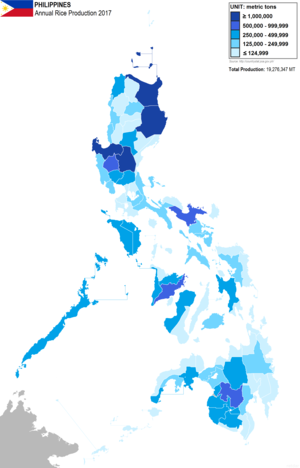
The Philippines is the 8th largest rice producer in the world, accounting for 2.8% of global rice production. The Philippines was also the world's largest rice importer in 2010. In 2010, nearly 15.7 million metric tons of palay (pre-husked rice) were produced. In 2010, palay accounted for 21.86% percent of gross value added in agriculture and 2.37% of GNP. Self-sufficiency in rice reached 88.93% in 2015.
Rice production in the Philippines has grown significantly since the 1950s. Improved varieties of rice developed during the Green Revolution, including at the International Rice Research Institute based in the Philippines, have improved crop yields. Crop yields have also improved due to increased use of fertilizers. Average productivity increased from 1.23 metric tons per hectare in 1961 to 3.59 metric tons per hectare in 2009.
Harvest yields have increased significantly by using foliar fertilizer (Rc 62 -> 27% increase, Rc 80 -> 40% increase, Rc 64 -> 86% increase) based on PhilRice National Averages.
The government has been promoting the production of golden rice. However, in April 2023, the Supreme Court of the Philippines issued a Writ of Kalikasan ordering the Department of Agriculture to stop the commercial distribution of genetically modified rice and eggplants in the country.
The table below shows some of the agricultural products of the country per region.
| Region | Rice | Corn/maize | Coconut | Sugarcane | Pineapple | Watermelon | Banana |
|---|---|---|---|---|---|---|---|
| Ilocos Region | 1,777,122 | 490,943 | 39,463 | 19,512 | 197 | 26,936 | 43,164 |
| Cordillera (CAR) | 400,911 | 237,823 | 1,165 | 51,787 | 814 | 141 | 26,576 |
| Cagayan Valley | 2,489,647 | 1,801,194 | 77,118 | 583,808 | 35,129 | 7,416 | 384,134 |
| Central Luzon | 3,304,310 | 271,319 | 167,737 | 678,439 | 1,657 | 7,103 | 58,439 |
| NCR | 0 | 0 | 0 | 0 | 0 | 0 | 0 |
| Calabarzon | 392,907 | 64,823 | 1,379,297 | 1,741,706 | 88,660 | 2,950 | 96,306 |
| MIMAROPA | 1,081,833 | 125,492 | 818,146 | 0 | 448 | 3,192 | 168,299 |
| Bicol Region | 1,264,448 | 243,908 | 1,105,743 | 239,010 | 130,595 | 5,598 | 76,452 |
| Western Visayas | 1,565,585 | 213,362 | 294,547 | 1,682,940 | 12,687 | 83,336 | 200,222 |
| Negros Island Region | 557,632 | 185,747 | 274,315 | 13,440,259 | 9,468 | 546 | 157,974 |
| Central Visayas | 269,801 | 101,333 | 274,069 | 241,573 | 998 | 1,161 | 126,220 |
| Eastern Visayas | 955,709 | 91,145 | 1,165,867 | 179,363 | 7,186 | 670 | 227,223 |
| Zamboanga Peninsula | 661,775 | 220,180 | 1,682,121 | 107 | 1,657 | 638 | 281,856 |
| Northern Mindanao | 725,120 | 1,216,301 | 1,851,702 | 3,065,463 | 1,468,386 | 2,024 | 1,832,173 |
| Davao Region | 441,868 | 224,100 | 2,246,188 | 208,743 | 26,880 | 1,070 | 3,455,014 |
| Soccsksargen | 1,291,644 | 1,239,275 | 1,159,818 | 680,383 | 794,334 | 2,132 | 1,159,091 |
| Caraga Region | 653,431 | 118,774 | 804,722 | 0 | 2,682 | 3,010 | 259,738 |
| ARMM | 488,215 | 673,036 | 1,393,168 | 113,343 | 921 | 80 | 531,048 |
Corn/maize
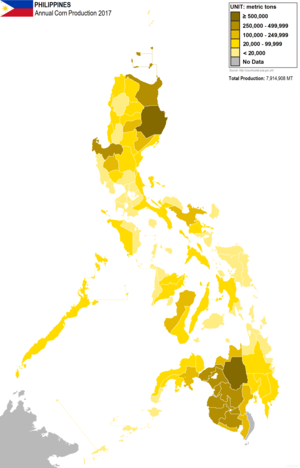
Corn/maize is the second most important crop in the Philippines. 600,000 farm households are employed in different businesses in the corn value chain. As of 2012, around 2.594 million hectares (6.41×10^ acres) of land is under corn cultivation and the total production was 7.408 million metric tons (8.166×10^ short tons). The government has been promoting Bt corn for hardiness against insects and higher yields.
Other food crops
Chocolate
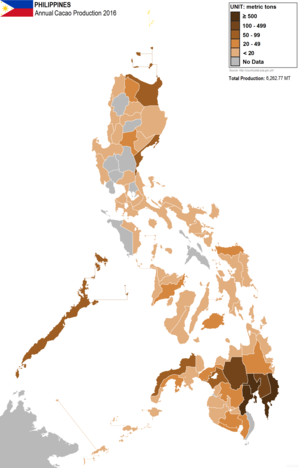
Coffee
This section is an excerpt from Coffee production in the Philippines.
Coffee is an important agricultural product in the Philippines, and is one of the Philippines' most important export products aside from being in high demand in the country's local consumer market.
The Philippines is one of the few countries that produce the four main viable coffee varieties; Arabica, Liberica (Barako), Excelsa and Robusta. 90 percent of coffee produced in the country is Robusta. There have been efforts to revitalize the coffee industry.
As of 2014, the Philippines produces 25,000 metric tons of coffee and is ranked 110th in terms of output. However local demand for coffee is high with 100,000 metric tons of coffee consumed in the country per year.
Coffee was said to have been introduced in the Philippines around 1696 when the Dutch introduced coffee in the islands. It was once a major industry in the Philippines, which by the 1800s was the fourth largest coffee producing nation.
However, Islamic culture has been pervaded by coffee drinkers from the 1500s. And with the close ties of the Philippines to the Islamic World since the 12th century, it would not be impossible to speculate that coffee has been in the Philippines before the Dutch "introduced" it.Coconuts
Further information: Coconut production in the PhilippinesCoconuts play an important role in the national economy of the Philippines. According to figures published in December 2015 by the Food and Agriculture Organization of the United Nations, it is the world's largest producer of coconuts, producing 19,500,000 tonnes in 2015. Production in the Philippines is generally concentrated in medium-sized farms. There are 3.5 million hectares dedicated to coconut production in the Philippines, which accounts for 25 percent of total agricultural land in the country. In 1989, it was estimated that between 25 percent and 33 percent of the population was at least partly dependent on coconuts for their livelihood. Historically, the Southern Tagalog and Bicol regions of Luzon and the Eastern Visayas were the centers of coconut production. In the 1980s, Western Mindanao and Southern Mindanao also became important coconut-growing regions.
Fruits
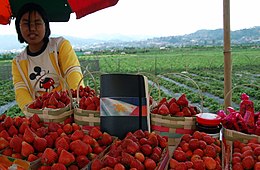
The Philippines is the world's third largest producer of pineapples, producing more than 2.4 million of tonnes in 2015. The Philippines was in the top three banana producing countries in 2010, including India and China. Davao and Mindanao contribute heavily to the total national banana crop. Mangoes are the third most important fruit crop of the country based on export volume and value next to bananas and pineapples.
Sugar
Further information: Sugar industry of the Philippines
There are at least 19 provinces and 11 regions that produce sugarcane in the Philippines. A range from 360,000 to 390,000 hectares are devoted to sugarcane production. The largest sugarcane areas are found in the Negros Island Region, which accounts for 51% of sugarcane areas planted. This is followed by Mindanao which accounts for 20%; Luzon by 17%; Panay by 07%; and Eastern Visayas by 04%. It is estimated that as of 2012, the industry provides direct employment to 700,000 sugarcane workers spread across 19 sugar producing provinces.
Sugar growing in the Philippines pre-dates colonial Spanish contact. Sugar became the most important agricultural export of the Philippines between the late eighteenth century and the mid-1970s. During the 1950s and 60s, more than 20 percent income of Philippine exports came from the sugar industry. Between 1913 and 1974, the Philippines sugar industry enjoyed favoured terms of trade with the US, with special access to the protected and subsidized the American sugar market.
Negros famine
This section is an excerpt from Negros famine. The Negros famine took place on Negros island in the Philippines in the mid-1980s, during the waning days of the Marcos dictatorship. It was a key moment in the history of sugar production in the Philippines, as well as the broader political history of the Philippines. Caused by the Marcos administration's efforts to control sugar production through the NASUTRA monopoly held by Marcos crony Roberto Benedicto and by a sudden crash in international sugar prices, it created what popularly came to be known as a "social volcano", with tensions culminating in the Escalante massacre, and with negative effects still felt even after the ouster of Ferdinand Marcos and his cronies during the 1986 People Power Revolution.Animal agriculture

Aquaculture
Aquaculture in the Philippines (which includes fish, shellfish, and seaweed farming) comprises 39% of the country's fisheries sector. The rest of the fisheries sector is composed of commercial and municipal fishing.
Some of the more common aquaculture products in the Philippines are bangus, tilapia, catfish and mudfish, and prawns.
Up to 27% of total aquaculture production comes from the Bangsamoro Autonomous Region in Mindanao.
Aquaculture accounts for 51% of fish produced in the country.
Climate change poses a major threat to fishing and fish farming in the Philippines.
Crocodile
This section is an excerpt from Crocodile farming in the Philippines.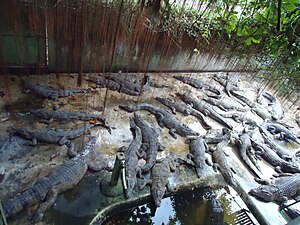
Crocodile farming in the Philippines refers to agricultural industries involving the raising and harvesting of crocodiles for the commercial production of Crocodile meat and crocodile leather.
In the Philippines, crocodile farmers breed and raise two species of Philippine crocodiles: the Philippine saltwater crocodile (Crocodylus porosus) and the Philippine freshwater crocodile (Crocodylus mindorensis). Farms that trade crocodile skin are regulated by the Convention on International Trade in Endangered Species (CITES).
Crocodiles help maintain the balance of Philippine ecosystems such as wetlands; crocodile farming in the Philippines is also geared towards the rescue and conservation of both C. porosus and the "endangered and endemic" C. mindorensis. Crocodile farms also contribute to tourism in the Philippines and offer public education about crocodiles.Ostrich
This section is an excerpt from Ostrich farming in the Philippines. The business of ostrich farming in the Philippines began in the Philippines in 1996. It was started by Lorenzo U. Limketkai, an engineer, and his son Heintje Limketkai. Heintje Limketkai took a month-long training course on ostrich farming in Australia. After that training, the Limketkais established their ostrich farming business and named it as the Philippine Ostrich and Crocodile Farms, Inc., becoming the first combined ostrich and crocodile farm in the country.Other crops
Abaca
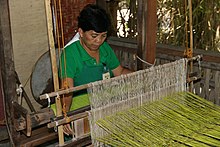
According to the Philippine Fiber Industry Development Authority, the Philippines provided 87.4% of the world's abaca in 2014, earning the Philippines US$111.33 million. The demand is still greater than the supply. The remainder came from Ecuador (12.5%) and Costa Rica (0.1%). The Bicol region in the Philippines produced 27,885 metric tons of abaca in 2014, the largest of any Philippine region. The Philippine Rural Development Program (PRDP) and the Department of Agriculture reported that in 2009–2013, Bicol Region had 39% share of Philippine abaca production while overwhelming 92% comes from Catanduanes Island. Eastern Visayas, the second largest producer had 24% and the Davao Region, the third largest producer had 11% of the total production. Around 42 percent of the total abaca fiber shipments from the Philippines went to the United Kingdom in 2014, making it the top importer. Germany imported 37.1 percent of abaca pulp from the Philippines, importing around 7,755 metric tons (MT). Sales of abaca cordage surged 20 percent in 2014 to a total of 5,093 MT from 4,240 MT, with the United States holding around 68 percent of the market.
Rubber
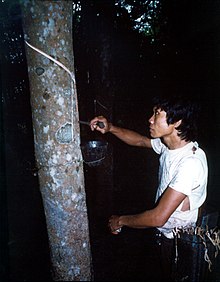
There are an estimated 458,000 families dependent upon the cultivation of rubber trees. Rubber is mainly planted in Mindanao, with some plantings in Luzon and the Visayas. As of 2013, the total rubber production is 111,204 tons.
Government
See also: Genetically modified food controversiesThe Food and Agriculture Organization described local policy measures as some of the most proactive in risk reduction.
The government supports the approval and cultivation of genetically modified crops. However, the Supreme Court issued injunctions against genetically modified products in 2015 and 2023. Farmers and environmentalists have held demonstrations and filed court petitions protesting the promotion, cultivation, and sale of genetically modified products in the Philippines.
Department of Agriculture
This section is an excerpt from Department of Agriculture (Philippines).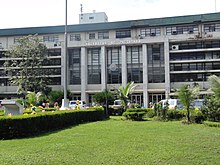
The Department of Agriculture (abbreviated as DA; Filipino: Kagawaran ng Pagsasaka) is the executive department of the Philippine government responsible for the promotion of agricultural and fisheries development and growth. It has its headquarters at Elliptical Road corner Visayas Avenue, Diliman, Quezon City.
The department is currently led by the secretary of agriculture, nominated by the president of the Philippines and confirmed by the Commission on Appointments. The secretary is a member of the Cabinet. The current secretary is Francisco Tiu Laurel Jr., who assumed office on November 3, 2023.Land reform
See also: Agricultural Land Reform Code (Philippines) and Department of Agrarian ReformThis section is an excerpt from Land reform in the Philippines. Land reform in the Philippines has long been a contentious issue rooted in the Spanish colonial period. Some efforts began during the American colonial period with renewed efforts during the Commonwealth, following independence, during martial law, and especially following the People Power Revolution in 1986. The current law, the Comprehensive Agrarian Reform Program, was passed following the revolution and extended until 2014.Environmental and social issues
Deforestation
Main article: Deforestation in the PhilippinesSome agricultural practices, including export crops and encroachment by small farmers, lead to deforestation. Deforestation may in turn affect water supply needed by farms.
Water supply and soil quality
Due to the loss of watershed areas, water supply and quality have decreased. Deforestation has also resulted in erosion and siltation, leading to worsened water quality.
Heavy use of chemical fertilizers have also led to declining soil quality.
Climate change
This section is an excerpt from Climate change in the Philippines § Agriculture.Agriculture is one of the Philippines' largest sectors and will continue to be adversely impacted by the effects of climate change. The agriculture sector employs 35% of the working population and generated 13% of the country's GDP in 2009. The two most important crops, rice and corn, account for 67% of the land under cultivation and stand to see reduced yields from heat and water stress. In addition to these challenges, the agricultural sector in the Philippines has also been significantly impacted by the drought conditions induced by El Niño. This phenomenon has led to considerable agricultural losses, estimated at about 4.4 billion pesos ($76.2 million). Nearly 78,000 hectares of agricultural land, predominantly used for rice cultivation, have been affected. Rice, wheat, and corn crops are expected to see a 10% decrease in yield for every 1 °C increase over a 30 °C average annual temperature.
Increases in extreme weather events will have devastating effects on agriculture. Typhoons (high winds) and heavy rainfall contribute to the destruction of crops, reduced soil fertility, altered agricultural productivity through severe flooding, increased runoff, and soil erosion. Droughts and reduced rainfall lead to increased pest infestations that damage crops as well as an increased need for irrigation. Rising sea levels increases salinity which leads to a loss of arable land and irrigation water.
All of these factors contribute to higher prices of food and an increased demand for imports, which hurt the general economy as well as individual livelihoods. From 2006 to 2013, the Philippines experienced a total of 75 disasters that cost the agricultural sector $3.8 billion in loss and damages. Typhoon Haiyan alone cost the Philippines' agricultural sector an estimated US$724 million after causing 1.1 million tonnes of crop loss and destroying 600,000 ha of farmland. The agricultural sector is expected to see an estimated annual GDP loss of 2.2% by 2100 due to climate impacts on agriculture.Land conversion
Agricultural areas are being subjected to land conversion to make way for development projects, to the detriment of farmers' welfare and the country's food security. According to former Department of Agriculture secretary Florencio Abad, farmlands are also being converted for non-agricultural purposes, such as for housing subdivisions, shopping centers, golf courses or recreation camps, export processing zones, and mining exploration. Massive land use conversion occurring in the country harms the agricultural sector in general and has negative effects on food security and rice supply. It also leads to higher prices for basic commodities and worsens the country's dependence on agricultural imports.
Poverty among farmers
See also: Endo contractualization and Labor policy in the Philippines § Labor issues Further information: Poverty in the PhilippinesFarmers and fishers belong to the poorest sectors of Philippine society. The incidence of poverty among farmers was estimated at 31.6% in 2018 (compared to the 16.7% national poverty incidence), according to data from the Philippine Statistics Authority.
Low-skilled agricultural workers usually receive wages at rates following the regional daily minimum wage set by the government. These rates are close to the national poverty threshold.
The issue of low wages may be compounded by landlessness among farmers, as well as contractual and informal work arrangements that do not provide job security or continuing access to statutory benefits (such as health benefits and other social safety nets). Contractual and informal work arrangements also create barriers that prevent farmers from exercising their constitutional right to free association and collective bargaining, which in turn prevent workers from gaining higher pay and developing new skills.
Occupational hazards
Farmers in the Philippines are exposed to various occupational safety and health hazards. These include exposure to harmful pesticides and chemical fertilizers, physical injuries, and long work hours, according to the International Labour Organization.
Human rights
Further information: Extrajudicial killings and forced disappearances in the Philippines and Red-tagging in the PhilippinesFarmers, fishers, land reform advocates, labor rights activists, and ancestral land defenders have been harassed or killed in the Philippines by state and non-state actors. During the 2021 commemoration of the Mendiola massacre, the Commission on Human Rights called for "an end to all killings and impunity in the country" and stressed "the need to protect the people's right to protest and express dissent, as well as to resist any move that would diminish or undermine the people's enjoyment of their rights". House Bill 1112 filed in Congress seeks to declare January 22 as National Farmer's Day.
See also
References
- De Leon, Remi (May 21, 2021), CRC holds its 2021 International Food and Agribusiness Investor Roadshow, Center for Research and Communication, University of Asia and the Pacific, retrieved October 31, 2023
- "Employment situation as of December 2022". psa.gov.ph. Philippine Statistics Authority. Archived from the original on February 8, 2023. Retrieved February 8, 2023.
- "Agriculture shared (%) of the total GDP". Philippine Statistics Authority. Retrieved February 22, 2023.
- "Philippines at a glance | FAO in the Philippines | Food and Agriculture Organization of the United Nations". www.fao.org. Retrieved March 29, 2021.
- ^ "Philippines at a glance | FAO in the Philippines | Food and Agriculture Organization of the United Nations". Food and Agriculture Organization. Retrieved March 29, 2021.
- Diamond, J. (April 25, 2003). "Farmers and Their Languages: The First Expansions". Science. 300 (5619): 597–603. Bibcode:2003Sci...300..597D. doi:10.1126/science.1078208. PMID 12714734. S2CID 13350469.
- Donohue, Mark; Denham, Tim (2010). "Farming and Language in Island Southeast Asia: Reframing Austronesian History". Current Anthropology. 51 (2): 223–256. doi:10.1086/650991. ISSN 0011-3204. JSTOR 10.1086/650991. S2CID 4815693.
- Bellwood, Peter (2006), "Asian Farming Diasporas? Agriculture, Languages, and Genes in China and Southeast Asia", Archaeology of Asia, Blackwell Publishing Ltd, pp. 96–118, doi:10.1002/9780470774670.ch6, ISBN 978-0-470-77467-0
- Denham, Tim (August 2012). "Early farming in Island Southeast Asia: an alternative hypothesis". Antiquity: 250–257.
- Eusebio, Michelle S.; Ceron, Jasminda R.; Acabado, Stephen B.; Krigbaum, John (2015). "Rice Pots or Not? Exploring Ancient lfugao Foodways through Organic Residue Analysis and Paleoethnobotany" (PDF). National Museum Journal of Cultural Heritage. 1: 11–20.
- Snow, Bryan E.; Shutler, Richard; Nelson, D.E.; Vogel, J.S.; Southon, J.R. (1986). "Evidence of Early Rice Cultivation in the Philippines". Philippine Quarterly of Culture and Society. 14 (1): 3–11. ISSN 0115-0243. JSTOR 29791874.
- Marci, Mia (June 21, 2019). "Why do Filipinos like to eat rice?". Pepper. Archived from the original on December 3, 2019. Retrieved December 3, 2019.
- "Incoming chief economist: PH agriculture already in crisis". CNN. June 21, 2022. Archived from the original on June 21, 2022. Retrieved January 14, 2024.
- 2022 Selected Statistics on Agriculture and Fisheries (PDF). Quezon City, Philippines: Philippine Statistics Authority. August 2022. Archived from the original (PDF) on May 7, 2023. Retrieved May 7, 2023.
- "Farm workers are paid an average daily wage of PhP 331.10 in 2019; CALABARZON farm workers are the highest paid while Central Visayas farm workers are the lowest paid". Philippine Statistics Authority. August 28, 2020. Retrieved May 7, 2023.
- ^ Villegas, Bernardo M.; Villegas, Pablito; De Leon, Remi (July 28, 2021). Scaling Up the Philippine Agribusiness by Integrating Smallholder Farms (YouTube Video). IGNITE AsiaPacific. Center for Research and Communication, University of Asia and the Pacific. Retrieved October 31, 2023.
- Habacon, John Patrick (March 13, 2021). "[OPINION] Why Filipino farmers suffer". Rappler. Retrieved June 1, 2023.
- "People's Review of SDG 1 & 10: Regressive gov't policies hinder poverty, inequality eradication". IBON Foundation. July 7, 2021. Retrieved June 1, 2023.
- "Board of Agriculture Resolution No. 02, Series of 2002" (PDF). Philippine Regulation Commission. Archived (PDF) from the original on April 30, 2021.
- Philippine Association of Agriculturists. "ANNOUNCEMENT: All Licensed Agriculturists Required to Submit a COGS to Renew their License". Philippine Association of Agriculturists.
- "Proposed Philippine Agriculturist Bill" (PDF). Philippine Association of Agriculturists. Archived (PDF) from the original on June 14, 2018.
- "Agriculture | Professional Regulation Commission". www.prc.gov.ph. Retrieved April 30, 2021.
- ^ "IRR of PRC Resolution No. 2000-663 (Resolution Creating the Board of Agriculture)" (PDF). Professional Regulation Commission. Board of Agriculturists. Retrieved April 30, 2021.
- "RESULTS: November 2019 Agriculturists Licensure Examination". Rappler. Retrieved April 30, 2021.
- "1,172 pass November Agriculturist Licensure Exam". Manila Bulletin. November 19, 2021. Retrieved November 19, 2021.
- November 18, PRC Board; Agriculturist, 2021 38 comments Categories; Passers, List of (November 18, 2021). "RESULTS: November 2021 Agriculturist Board Exam Passers". PRC Board. Retrieved February 8, 2022.
{{cite web}}: CS1 maint: numeric names: authors list (link) - "Republic Act 8435, Agricultural and Fisheries Modernization Act of 1997.pdf" (PDF). Professional Regulation Commission. Retrieved April 30, 2021.
- Professional Regulations Commission. "PRC Resolution No. 2000-663, Series of 2000" (PDF). Professional Regulations Commission.
- ^ "2009 Crop Production Statistics". FAO Stat. FAO Statistics. Retrieved March 30, 2011.
- "Factbox – Top 10 rice exporting, importing countries". Reuters. January 28, 2011. Archived from the original on March 5, 2016. Retrieved March 30, 2011.
- "Palay: Volume of Production by Cereal Type, Geolocation, Period and Year". CountrySTAT Database. Bureau of Agricultural Statistics. Archived from the original on March 20, 2011. Retrieved March 30, 2011.
- "Philippine economy posts 7.1 percent GDP growth". National Accounts of the Philippines. National Statistical Coordination Board. Archived from the original on April 15, 2011. Retrieved March 30, 2011.
- Authority, Philippine Statistics. "Self-Sufficiency Ratio of Selected Agricultural Commodities". countrystat.psa.gov.ph. Archived from the original on October 28, 2016. Retrieved October 28, 2016.
- Romero, Michael L. (July 1, 2022). AN ACT PROVIDING THE DEPARTMENT OF AGRICULTURE (DA) WITH ADDITIONAL FUNDING, INCREASING ITS YEARLY ALLOTMENT, AND FOR OTHER PURPOSES (PDF).
- ^ Freedman, Amy (2013). "Rice security in Southeast Asia: beggar thy neighbor or cooperation?". The Pacific Review. 26 (5). Taylor & Francis: 433–454. doi:10.1080/09512748.2013.842303. ISSN 0951-2748. S2CID 153573639. p. 443
- Servallos, Neil Jayson (April 20, 2023). "SC issues writ vs GMO golden rice, eggplant". Philippine Star. Retrieved May 6, 2023.
- "Philippine Statistics Authority: CountrySTAT Philippines". Archived from the original on October 28, 2016. Retrieved October 28, 2016.
- ""Agri-Pinoy Corn Program", Republic of Philippines Department of Agriculture". da.gov.ph. Archived from the original on January 22, 2014. Retrieved January 22, 2014.
- Peace and Equity Foundation. A primer on PEF’s Priority Commodities: an Industry Study on Cacao Archived May 2, 2021, at the Wayback Machine. Philippines, 2016. 2. Accessed June 26, 2017.
- De Leon, Remi (May 21, 2021), CRC holds its 2021 International Food and Agribusiness Investor Roadshow, Center for Research and Communication, University of Asia and the Pacific, retrieved October 31, 2023
- ^ Flores, Wilson Lee (January 13, 2014). "How can the Philippines be a top coffee exporter again?". The Philippine Star. Retrieved November 15, 2015.
- "Coffee's Rich History in the Philippines". Philippine Coffee Board. Philippine Coffee Board. Retrieved November 15, 2015.
- Imbong, Peter (December 18, 2014). "Philippines tries to reignite production". Nikkei Inc. Nikkei Asian Review. Retrieved November 15, 2015.
- "Who really brought coffee first to the Philippines? A food historian offers some answers". ABS-CBN News. October 14, 2022.
- Merican, A Murad (May 4, 2020). "Islam removed from coffee's history". New Straits Times.
- "FAOSTAT". www.fao.org. Archived from the original on September 6, 2015.
- Hayami, Yūjirō; Quisumbing, Maria Agnes R.; Adriano, Lourdes S. (1990). Toward an alternative land reform paradigm: a Philippine perspective. Ateneo de Manila University Press. p. 108. ISBN 978-971-11-3096-1. Retrieved November 15, 2011.
- "Philippines to launch coconut cluster". Investvine.com. February 16, 2013. Retrieved February 22, 2013.
- ^ Ronald E. Dolan, ed. Philippines: A Country Study. Washington: GPO for the Library of Congress, 1991.
- fao.org. "Food and Agricultural commodities production > Countries by commodity > Pineapples (2013)". Retrieved July 12, 2016.
- ^ "banana". Archived from the original on December 1, 2015. Retrieved March 17, 2015.
- "mango". Archived from the original on December 28, 2014. Retrieved March 17, 2015.
- Master Plan For the Philippine Sugar Industry. Sugar Master Plan Foundation, Inc. 2010. p. 7.
- Master Plan For the Philippine Sugar Industry. Sugar Master Plan Foundation, Inc. 2010. pp. 4–6.
- ^ "History". Retrieved March 17, 2015.
- Francisco, Katerina (September 22, 2016). "Martial Law, the dark chapter in Philippine history". Rappler. Archived from the original on September 23, 2016. Retrieved June 29, 2018.
- Manapat, Ricardo (1991). Some are smarter than others: the history of Marcos' crony capitalism. New York: Aletheia Publications. ISBN 9719128704. OCLC 28428684.
- Caña, Paul John (May 15, 2021). "Sugar Wars: Looking Back at the Negros Famine of the 1980s". Esquiremag.ph. Retrieved August 15, 2022.
- Tadem, Eduardo Climaco (July 3, 2015). "Technocracy and the Peasantry: Martial Law Development Paradigms and Philippine Agrarian Reform". Journal of Contemporary Asia. 45 (3): 394–418. doi:10.1080/00472336.2014.983538. ISSN 0047-2336. S2CID 154354138.
- ^ Viray-Mendoza, Vicky (January 25, 2019). "The Fishing Industry in the Philippines". The Maritime Review. Retrieved January 28, 2023.
- "51% of fish produced in the Philippines comes from aquaculture". Aquaculture Magazine. February 2, 2022. Retrieved January 28, 2023.
- "Aquaculture In The Philippines, How To Start | Agri Farming". Agri Farming. August 24, 2021. Retrieved January 28, 2023.
- ^ "Crocodiles in the Philippines". Department of Environment and Natural Resources (DENR). Retrieved December 28, 2013.
- ^ Regalado, Edith (July 5, 2013). "Louis Vuitton buying Phl croc skins". The Philippine Star
- "About us, Philippine Ostrich & Crocodile Farms, Inc. PIONEERING THE OSTRICH INDUSTRY IN THE PHILIPPINES". Philippine Ostrich & Crocodile Farms, Inc. Retrieved December 26, 2013.
- "Philippine Ostrich & Crocodile Farm". Municipality of Opol (08 October 2013). Retrieved January 15, 2014.
- ^ "PH biggest abaca exporter | Malaya Business Insight". Malaya Business Insight. June 15, 2015. Archived from the original on August 9, 2016. Retrieved October 8, 2016.
- "rubber". Archived from the original on December 1, 2015. Retrieved March 17, 2015.
- "Food and Agricultural commodities production / Countries by commodity". Retrieved May 27, 2016.
- Ordoñez, John Victor (April 19, 2023). "SC issues Writ of Kalikasan vs Golden Rice, Bt eggplant". Business World Online. Retrieved May 6, 2023.
- Punay, Edu (December 8, 2015). "SC stops field testing of genetically modified eggplants". Philippine Star. Retrieved May 6, 2023.
- "Department of Agriculture – Mandate, Mission and Vision". Archived from the original on December 21, 2012. Retrieved October 28, 2012.
- ^ "Averting an agricultural and ecological crisis in the Philippines' salad bowl". Mongabay Environmental News. March 13, 2020. Retrieved March 29, 2021.
- ^ Crost, Benjamin; Duquennois, Claire; Felter, Joseph H.; Rees, Daniel I. (March 2018). "Climate change, agricultural production and civil conflict: Evidence from the Philippines". Journal of Environmental Economics and Management. 88: 379–395. Bibcode:2018JEEM...88..379C. doi:10.1016/j.jeem.2018.01.005. hdl:10419/110685. S2CID 54078284.
- "Over 100 Philippine Towns in State of Calamity Amid Drought". Bloomberg.com. April 30, 2024. Retrieved April 30, 2024.
- ^ "Climate Change Risk in the Philippines: Country Fact Sheet" (PDF). USAID. February 2017.
- Chandra, Alvin; McNamara, Karen E.; Dargusch, Paul; Caspe, Ana Maria; Dalabajan, Dante (February 2017). "Gendered vulnerabilities of smallholder farmers to climate change in conflict-prone areas: A case study from Mindanao, Philippines". Journal of Rural Studies. 50: 45–59. Bibcode:2017JRurS..50...45C. doi:10.1016/j.jrurstud.2016.12.011.
- Macaraeg, Aaron (October 10, 2019). "Agriculture budget not enough to help small farmers". Bulatlat. Retrieved January 28, 2023.
- ^ Oliveros, Benjie (April 7, 2008). "Ex-Agri Secretary Says Massive Land Use Conversion Hurts Food Status". Bulatlat. Retrieved February 3, 2023.
- "Farmers, Fisherfolks, Individuals Residing in Rural Areas and Children Posted the Highest Poverty Incidences Among the Basic Sectors in 2018 | Philippine Statistics Authority". Philippine Statistics Authority. June 3, 2020. Retrieved January 30, 2023.
- "Proportion of Poor Filipinos was Estimated at 16.6 Percent in 2018 | Philippine Statistics Authority". Philippine Statistics Authority. December 6, 2019. Retrieved January 30, 2023.
- ^ "Five studies of the Philippine agriculture sector: Summary analysis and policy recommendations". International Labour Organization. April 22, 2022: 71.
{{cite journal}}: Cite journal requires|journal=(help) - "Farm safety: A new beginning". International Labour Organization. April 23, 2018. Retrieved February 3, 2023.
- "Statement of CHR Spokesperson, Atty Jacqueline Ann de Guia, on the 34th Anniversary Commemoration of Mendiola Massacre". Commission on Human Rights. January 22, 2021. Retrieved May 7, 2023.
- Abarca, Charie Mae (January 22, 2023). "Group demands enactment of National Farmers' Day bill". Manila Bulletin. Retrieved May 7, 2023.
Further reading
- Jesus, Ed. C. De (1980). The Tobacco Monopoly in the Philippines: Bureaucratic Enterprise and Social Change, 1766–1880. Ateneo University Press. ISBN 9715501680. Retrieved April 24, 2014.
External links
- [REDACTED] Media related to Agriculture in the Philippines at Wikimedia Commons